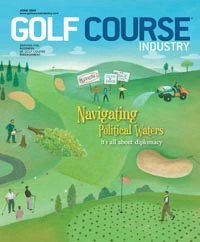The presence of several new turfgrass diseases has increased on golf courses in the United States recently. Three new diseases in particular – Pythium root dysfunction, brown ring patch and rapid blight – are challenging for golf course superintendents. Fortunately, researchers have made headway detecting and treating these destructive diseases.
Tackling new diseases
| IMPACT ON THE BUSINESS |
Getting to the root of the Southeast’s Pythium disease The good news for Charles Sheffield, superintendent at Croasdaile Country Club in Durham, N.C., is that only one disease significantly disturbs his turf. The bad news is that it’s Pythium root dysfunction, caused by Pythium volutum. Golf course superintendents and plant pathologists living in the Southeast are learning that Pythium root dysfunction on creeping bentgrass greens is a plague. Since 2002, Pythium root dysfunction caused by Pythium volutum has been observed attacking greens at 40 to 50 golf courses in the Southeastern U.S. and is limited to newly constructed greens younger than eight years old. Bentgrass is most susceptible to infection, and in a matter of weeks, if left untreated, the pathogen can cause serious decline, with the ability to wipe out entire greens. Unlike the more common warm-season Pythium root rot, in which infection is visible quickly, this unknown disease doesn’t display symptoms. When the weather becomes warmer and the turf becomes stressed from high heat, continued close mowings, low fertility schedules and drought-causing weather patterns, the disease manifests itself with brown blotch-like or blighted irregular patches of turfgrass. Attempts to treat the disease through cultural controls such as syringing greens to keep them moist, raising mower blade heights and increasing fertility have aided turfgrass recovery but haven’t hindered the pathogen’s damage. And fungicides that effectively treat Pythium blight on bentgrass haven’t stopped the turfgrass decline. “This disease is different than anything else we’ve seen here,” Sheffield says. Sheffield first noticed patches of discoloration, ranging from the size of a golf ball to a steering wheel, in early March 2002 when the course reopened after construction. The spring heat brought out the discolored patches on the nubs, slopes and greens of the course – high traffic areas where the turf was more susceptible to stress and drying out. Sheffield used pyraclostrobin, at 0.9 ounces per 1,000 square feet, in his rotation and was able to get four weeks of control. He continues to apply the active ingredient preventively and plans to make an application in the cooler fall season, when the disease is likely to infect the turf. In a 2004 study, Lane Tredway, Ph.D., turfgrass pathologist at North Carolina State University, found pyraclostrobin provided preventative and curative control of this formerly unknown disease on bentgrass. Plots treated with pyraclostrobin exhibited significantly lower disease severity than the untreated control in the curative control study. In the preventive control study, pyraclostrobin plots were almost free of disease symptoms 43 days after the last application was made. Tredway noted in his study that preventive applications might be more effective in the fall and early spring, which is when this disease appears to be most active. Sheffield will continue to unravel the mystery of this emerging turf disease along with the rest of the superintendents in his area, while monitoring the research being conducted at N.C. State. GCI |
New turfgrass diseases can evolve for a number of reasons, and several factors contribute to the prevalence of disease such as geography, moisture and temperature.
Stress caused by heat, drought and excess moisture can weaken turf, making it more prone to disease. Simply put, healthy turf is less susceptible to disease. The challenge with golf courses, particularly on greens, is that turfgrass is kept short by plant growth regulators and/or frequent mowing, which causes stress.
Players expect superintendents to provide the best of both worlds – short grass and healthy turf. It’s a difficult balance, especially when new diseases emerge and superintendents don’t know how to treat them.
University and industry researchers are addressing these three emerging problem diseases. To avoid being caught off-guard, superintendents should learn more about these diseases. Doing so will help identify and treat the diseases, and in some cases, avoid them altogether.
Pythium root dysfunction
Discovered in North Carolina in 1994, Pythium root dysfunction attacks putting greens and is limited to newly constructed greens younger than eight years old. It’s most commonly found in the Southeast but also occurs in Midwestern areas with harsh summers. Bentgrass is most susceptible to the disease, which occurs on turf stressed from one or more of the following factors:
• High heat.
• Repeated close mowing.
• Low fertility schedules.
• Drought.
Pythium root dysfunction causes the roots and crown of turfgrass to turn brown or black. The symptoms are most visible during the summer, but the disease spreads during spring and fall, when it’s cool and wet.
Because symptoms are less prevalent on plants with strong root systems, there are several cultural practices superintendents can undertake to minimize damage caused by Pythium root dysfunction. Root enhancement techniques – specifically aerification, nutrition supplements, verticutting and reduced irrigation – are helpful to counteract symptoms of the disease.
Irrigation management also is extremely important. Clay and compacted soils are more likely to harbor Pythium root dysfunction because of reduced drainage.
It’s less difficult and less expensive to prevent Pythium root dysfunction than it is to try to cure it. Fungicides such as pyraclostrobin and triticonazole are two of the most effective at preventing the disease.
Lane Tredway, Ph.D., turfgrass pathologist at North Carolina State University, is one of the foremost experts on Pythium root dysfunction. To learn more about his research and information on N.C. State’s Center for Turfgrass Environmental Research & Education, visit www.turffiles.ncsu.edu.
Brown ring patch
Formerly known as waitea patch, brown ring patch has been reported sporadically throughout the Midwest and is a mounting problem in Southern California. Occurring primarily on greens with high annual bluegrass (Poa annua) populations, the disease is prevalent in warm and moist conditions.
Initial symptoms of brown ring patch are thin, yellow, concentric rings several inches in diameter that turn brown under hot or wet conditions. Once established, brown ring patch can quickly damage turfgrass. Temperature plays a significant role in whether or not brown ring patch occurs. The disease doesn’t spread in hot or cold conditions, but rather during times of mild temperature (middle 60s to low 80s F).
Cultural control options of aerification and higher mowing heights are sometimes used to combat brown ring patch. Alternating among several fungicides – pyraclostrobin, propiconazole and triticonazole – has been an effective treatment.
Frank Wong, Ph.D., assistant plant pathologist at the University of California-Riverside, is considered one of the top brown ring patch researchers.
Rapid blight
Rapid blight occurs in the fall and winter, affecting several annual winter grasses used to overseed Bermudagrass. Affected species include ryegrass, annual bluegrass and Poa trivialis. It’s primarily seen in the Southwest, including Nevada, Arizona and Southern California, as well as on coastal areas in the Southeast and Northeast. Perennial grasses aren’t affected by rapid blight.
The disease is associated with a marine organism and cases of rapid blight rise significantly in areas where superintendents use reclaimed water or water with high salinity for irrigation. The disease can occur on any area that has been overseeded but is usually treated only on putting greens.
Mary Olsen, Ph.D., plant pathology specialist for the University of Arizona-Tucson, has confirmed rapid blight is caused by an obscure microorganism that, before its discovery in turf, was known to infect marine plants such as seagrass, diatoms and algae. The University of Arizona’s division of plant pathology and microbiology is available at http://ag.arizona.edu/PLP.
Rapid blight shows itself as water-soaked, slightly sunken and darker-looking turf. It turns yellow and dies in patches.
The primary cultural control option is to use better quality irrigation water, avoiding reclaimed water, if possible. Pyraclostrobin provides the most effective preventative control; mancozeb is a less effective alternative.
Prevention and education
To avoid being caught off-guard by new diseases, it’s important to stay educated, be consistent with preventative tactics and devote time to detection efforts.
Part of being proactive is keeping up with the latest research and information about turfgrass disease. Superintendents who collect and absorb background information are better prepared when they encounter a problem. They know what they’re dealing with and who can help them.
Some superintendents are quick to write off an undiagnosed problem as untreatable by a particular fungicide they’ve already applied, and they simply re-treat with a different product. Instead, they should take a turf sample and send it in to a diagnostics lab.
Fungicide manufacturer representatives, university extension personnel and other golf course superintendents also are good sources of information. It’s wise for superintendents to seek the help of others if they encounter an abnormality they don’t recognize.
It’s common sense, but it’s important for superintendents to walk their courses daily, keeping an eye out for abnormalities. New diseases such as Pythium root dysfunction, brown ring patch and rapid blight can cause problems quickly if undetected. GCI
Todd Burkdoll is a market development specialist for BASF Turf and Ornamentals.
Get curated news on YOUR industry.
Enter your email to receive our newsletters.
Explore the June 2008 Issue
Check out more from this issue and find your next story to read.
Latest from Golf Course Industry
- GCSAA’s Health in Action 5K/2K reaches fundraising goal
- Landscapes Golf Management to participate in data analyzation initiative
- Reel Turf Techs: Carl Michael
- Atlanta Athletic Club approves funding for master plan
- Maximizing Cultural Practices and Agronomic Benefits with Minimal Surface Disruption
- Real Answers about Spray Nozzle Choices
- From the Course to the Factory: How Customer Insights Drive Innovation
- New & Proven Enzyme Strategies for Sprayable Thatch Management





